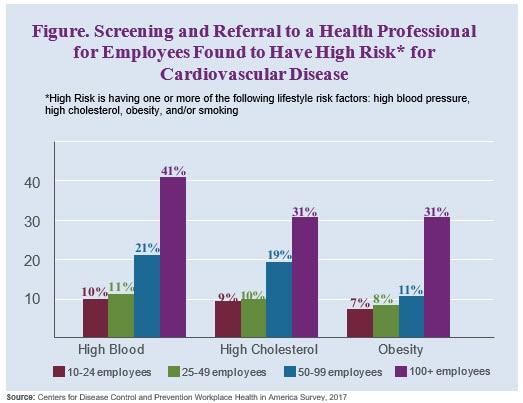Cardiovascular Disease Screening and Referral by Small Worksites: A Positive Return on Investment
Available for Download pdf icon[PDF – 151 KB]
Heart Disease and Stroke are Bad for Business
Cardiovascular Disease (CVD) is America’s costliest disease.1 Heart-healthy employees have better morale, miss less work, and are more productive than less healthy employees. Fortunately, employers can help their employees maintain their heart health.2,3
On average, an employee with CVD costs his or her employer over a week in absences and $1,100 more on lost productivity each year than an employee without CVD.1 However, a recent study showed that 40% of employees were not aware of the level of at least one of their CVD risk factors (high blood pressure, high cholesterol, and obesity).4 Furthermore, in another study, it is estimated that 36% of the US adult population with uncontrolled blood pressure (about 13 million people) are neither aware of their hypertension nor taking medications to control it.5
Workplace Health Screenings and Referrals are Good for Business
Conducting health screenings and referrals in the workplace is a promising strategy for early detection of CVD risk factors, with the goal of preventing the onset of CVD, or managing CVD for those who have been diagnosed. In particular, screenings may motivate employees to seek healthcare if they were previously unaware of their risk factors.6 Employer healthcare costs can be avoided through worksite-based health screening. Employers can achieve a positive return on investment when employee health screening is offered with a well-designed comprehensive health and wellness program, estimated at approximately $2.50 – $10.00 saved due to reduced absenteeism and medical costs per $1 invested in wellness activities.6
Small Worksites Can Conduct Screening and Referrals
Because 98% of all employers are small, the collective impact of small worksites to identify CVD risk factors and refer individuals to healthcare professionals is immense.7 Nationally, there are opportunities for more screening and referral within small worksites.

MERIL Screens Employees for CVD Risk Factors
Midland Empire for Independent Living (MERIL), of St. Joseph,
Missouri empowers people with disabilities by providing a range of independent living services to clients. Their staff of approximately 50 employees is offered on-site biometric screening for obesity and high blood pressure as part of their worksite’s comprehensive wellness program. The workplace uses results to set wellness goals for the coming year.
A Low Cost Way to Help Employees with High Blood Pressure
In addition to screening and referral, 25% of all employers provide self-measured blood pressure monitoring devices to employees8; this low-cost strategy can help employees with high blood pressure to monitor their health condition while at work. Self-measured blood pressure monitoring can improve blood pressure outcomes in employees.9
- American Heart Association / American Stroke Association. Cardiovascular Disease: A Costly Burden for America. Projections through 2035.
- Certifed B Corporation. B Resource Guide: Creating an Employee Wellness Program. https://www.rwjf. org/content/dam/farm/toolkits/toolkits/2011/ rwjf400786external icon.
- Linnan L, Weiner B, Graham A, Emmons K. Manager Beliefs Regarding Worksite Health Promotion Programs: Findings from the Working Healthy Project 2. American Journal of Health Promotion. 2007:JulAug;21(6):521-8.
- Jacobs JC, Burke S, Rouse M, Sarma S, Zaric G. Cardiovascular disease risk awareness and its association with preventive health behaviors. Journal of Occupational and Environmental Medicine. May 2016;58(5):459-465.
- Wall HK, Hannan JA, Wright JS. Patients with undiagnosed hypertension: hiding in plain sight. Journal of the American Medical Association. 2014;312(19):1973-1974.
- Ross A, Arnett DK, Terry PE, Li S, Isaac F, Mosca L, Braun L, Roach WH, Pate RR, Sanchez E, Carnethon M, Whitsel LP. The role of worksite health screening: A policy statement from the American Heart Association. Circulation. 2014;130:719-734.
- US Census Bureau. 2014 Statistics of US Businesses (SUSB) Program County Business Patterns Survey.
- Centers for Disease Control and Prevention Workplace Health in America Survey, 2017.
- Community Preventative Services Task Force. Self-Measured Blood Pressue Monitoring Improves Outcomes: Recommendation of the Community Preventative Services Task Force. American Journal of Preventative Medicine, 2017; 53(3); e115-e118.